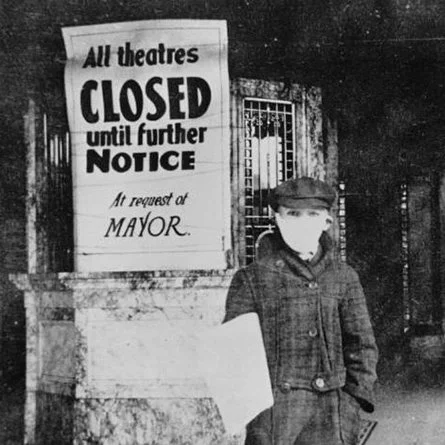The Influenza Pandemic of 1918: Spanish Flu in New Britain
As we enter into the third year of the COVID-19 pandemic, with the words ‘unprecedented times’ ringing in our ears, it’s easy to feel as though we’ve never gone through anything like this before. However, just over one hundred years ago, we did: the influenza pandemic of 1918, or the Spanish Flu pandemic swept across the globe, leaving devastation in its wake. Originating in Haskell County, Kansas in early January 1918 and spreading to Europe through American troops fighting in the Great War, it ravaged the state of Connecticut for three months and caused at least 9000 deaths. More than 675,000 deaths nationwide can be attributed to the 1918 pandemic. It was a disease that caused rapid fatality: within hours or days, infected victims succumbed to secondary pneumonia, suffocating on fluid in their own lungs. The disease was utterly devastating, and at the time there were no vaccines or adequate medicines to treat the virus.
In Connecticut, and up and down the East coast, the high concentration of military bases and camps led to the rapid spread of the virus. Now London saw the first cases in the state, and by the end of September the number of cases neared one thousand. In October alone, the flu caused more than 5000 fatalities. Without enough doctors, nurses, or hospital beds to respond to the needs of thousands of flu victims, Connecticut was in a state of desperation. Though New Britain initially offered to send aid to Camp Devens in Massachusetts, the city was rapidly overcome. Private homes and clubs were opened to serve as emergency hospital facilities and volunteers stepped up for nursing duties, including the Hartford Golf Club.
All over the state, theaters and other public spaces shut shown. Trolleys and bus lines limited passengers and staggered schedules to help combat the spread of the flu. Image courtesy of Connecticut College.
Dr. Theron L. Blackledge, pictured c. 1925. Courtesy of New Brighton Public Library.
"Coughs and Sneezes Spread Diseases - As Dangerous as Poison Gas Shells". U.S. Public Health ad, 1918. Printed in The Danbury News, October 9, 1918.
In New Britain, the New Britain Hospital could not contain the sheer number of flu victims. Two soldiers returning to New Britain from the war front via Fort Devens in Massachusetts are said to have brought the disease to New Britain on Sept. 18, 1918, according to the New Britain Health Dept. By early October, nurses and doctors themselves were falling ill. A Danbury News headline said the flu was “Sweeping Through New Britain Like Prairie Fire. Many Are Dying. Doctors Are Exhausted… Great Need of Nurses.” With 1516 cases and counting, Mayor George A. Quigley’s offer of his home for a temporary overflow hospital was quickly accepted.
“To Prevent Influenza!” Public health recommendations from the 1918 Illustrated Current News, New Haven, CT
Among the hardest hit were immigrant populations: the poor and newly arrived immigrants living in crowded tenement houses, factory workers in close quarters spending long hours on the manufacturing floors, and groups of young single men or single women living together in boarding houses. With so few healthcare workers, it fell to outside help to provide aid to New Britain’s dying population. Dr. Theron Blackledge (1873-1959) traveled to New Britain from New Brighton, PA at the request of the State Board of Health and courageously went house to house to treat victims of the highly contagious disease. He was hired in order to help take the strain off New Britain’s local physicians, who were inundated with calls and overwhelmed by the needs of the city. “The physicians are working day and night, and many of them are beginning to show the strain,” the Courant reported. Dr. Blackledge wired home in early October to request more nurses, but they could not be spared, and thus he was left to attend both the hospital and homebound patients by himself. As cases declined, the grateful city presented a gold Hamilton watch– the manufacturer’s highest quality at that time– inscribed from Mayor Quigley. The watch is now part of the New Britain Industrial Museum’s permanent collection.
The watch presented to Dr. Blackledge by Mayor Quigley, now part of the NBIM permanent collection. Inscription reads “Presented to Dr. Theron L. Blackledge by Mayor Geo. A Quigley for services rendered the City of New Britain, Nov 1, 1918”.
In November, the Hartford Courant declared the ninety-day pandemic deadlier than the four-year war that had just ended. Although cases of the influenza continued into 1919, the worst had passed and the city could begin recovery. New Britain alone had lost nearly 700 residents in the span of three months to the disease, and it remained the deadliest pandemic in American history until it was supplanted by the COVID-19 pandemic in late September, 2021.
For Kids and Families
Gilbert, J., & Forsyth, M. (2020). Daisy and the Deadly Flu: A 1918 Influenza Survival Story. Stone Arch Books, a Capstone imprint.
Getz, D., & McCarty, P. (2017). Purple Death: The Mysterious Spanish Flu of 1918. Square Fish.
Little, J. (2014). If I Die Before I Wake: The Flu Epidemic Diary of Fiona Macgregor, Toronto, Ontario, 1918. Scholastic Canada, Limited.
McElroy, J., & McElroy, S., MD (2014, November 12). Influenza. Sawbones: A Marital Tour of Misguided Medicine. Retrieved from https://maximumfun.org/episodes/sawbones/sawbones-influenza/
Further Reading
Arcari, R. D. (2007). Spanish flu epidemic: Ninety Days that sickened Connecticut. Connecticut Explored. Retrieved from https://www.ctexplored.org/ninety-days-that-sickened-connecticut/
Drury, D. (2020, September 15). The Spanish Influenza Pandemic of 1918. Connecticut History | a CTHumanities Project. Retrieved from https://connecticuthistory.org/the-spanish-influenza-pandemic-of-1918/
History.com Editors. (2010, October 12). Spanish Flu. History.com. Retrieved from https://www.history.com/topics/world-war-i/1918-flu-pandemic
Spinney, L. (2021). Pale Rider: The Spanish flu of 1918 and how it changed the world. Langara College.
Quinn, T. (2008). Flu: A Social History of Influenza. New Holland.


